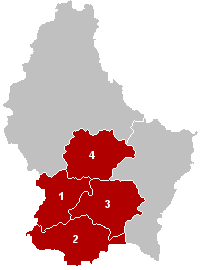Luxembourg District facts for kids
The District of Luxembourg was one of three main administrative areas, called districts, in the country of Luxembourg. Think of it like a big region within the country.
This district was made up of four smaller areas called cantons. These cantons were then divided into many local areas known as communes. In total, the District of Luxembourg had 44 communes.
Contents
What Was Inside the District?
The District of Luxembourg included four cantons. Each canton had several communes, which are like towns or local government areas.
The Cantons
The four cantons that made up the District of Luxembourg were:
These cantons contained all the 44 communes. Some well-known communes included Luxembourg City itself, which is the capital, and other important towns like Differdange and Dudelange.
Where Was It Located?
The District of Luxembourg was located in the southern part of the Grand Duchy of Luxembourg. It shared borders with several other places:
- To the east, it bordered the Grevenmacher district.
- To the north, it bordered the Diekirch district.
- To the west, it touched the Belgian province of Luxembourg, which is part of Wallonia.
- To the south, it bordered the French area called Moselle, which is in the Grand Est region.
An Important and Wealthy Area
The District of Luxembourg was known for being a very important and wealthy part of the country. It had the highest per capita income among all the districts in Luxembourg. "Per capita income" means the average amount of money earned by each person in that area. In this district, the average income was about $72,300 per person. This showed how economically strong the region was.
When Did the Districts End?
The way Luxembourg was organized changed in 2015. On October 3, 2015, all three districts of Luxembourg, including the District of Luxembourg, were officially abolished. This means they no longer exist as administrative divisions. Now, the country is organized differently, directly into cantons and communes.
See also
- In Spanish: Distrito de Luxemburgo para niños


